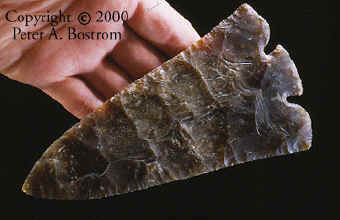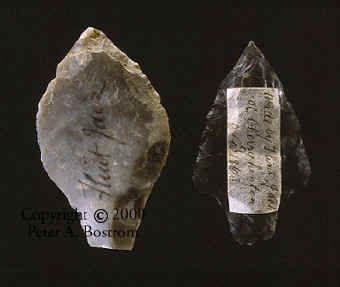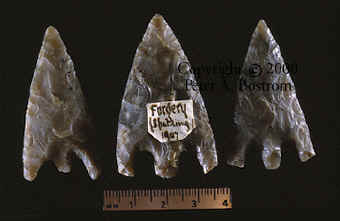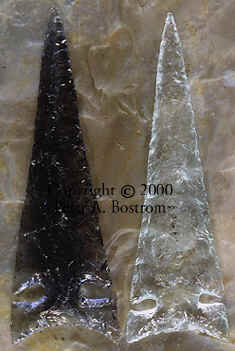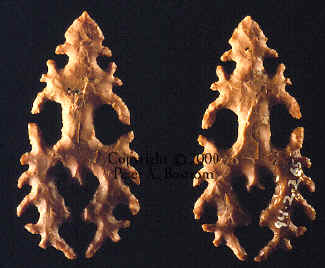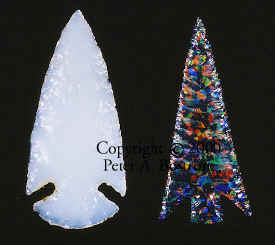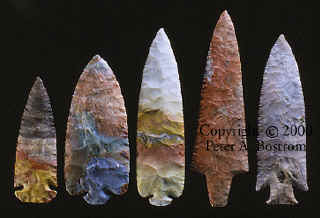|
THE MODERN ART OF FLINTKNAPPING |
|
|
|
1886
"Flint
Jack" One of the earliest recorded Europeans who became involved in the art of flintknapping in modern times is a man called Edward Simpson. He was also known as "Flint Jack". He made these two points sometime in the middle 1800's. The example on the right has "Cherry Hinton, Nov. 1868" written on it. Edward Simpson was one of the earliest experimental stone tool makers who became proficient at replicating several different types of ancient stone artifacts found in his home country of England. He used a steel hammer to make them. Then added to their appearance by using chemicals and a lapidary tumbler to apply an artificial patination. These he then sold to an unsuspecting Victorian public. Over 130 years ago, just as they are today, people purchased stone artifacts they thought were old but are actually only modern copies. The longest in this picture is 1 11/16 inches. |
|
1907
Mr.
Spalding The basal notched point in the center of this group was made by a Mr. Spalding in 1907 in England. The style of arrow point he copied here is like the two authentic examples on either side. The authentic points date to the Late Neolithic Period approximately 3,700 to 3,500 years ago. The early flintknappers from Great Britain may have been connected with the gun flint trade in the Brandon, England area. |
|
1911
Ishi
These arrow points were made by Ishi, who became famous after he wandered
out of the wilderness in 1911 after his family was killed by local white
settlers. He became known as the last "Wild Indian" and
eventually came into the hands of T. T. Waterman and Alfred l. Kroeber,
anthropologists who recorded his language and studied his native crafts.
He was well advertised in the newspapers of his time and in the next five
years thousands of visitors watched him chip Arrow points, shape bows and
make fire using skills that were developed through countless generations.
He died only five years later of tuberculosis. Ishi was the last of his
tribe who he called the Yahi. They were a separate group of Indians not
yet recorded and even spoke a different language. The year Ishi entered
the white man's world in 1911 scientists have designated as the end of the
Historic Period in North America. |
|
1960's
and 1970's
Crabtree Don Crabtree and Francois Bordes are the two people mainly credited with beginning scientific studies in experimental archaeology that actually copied ancient stone tools using the same manufacturing techniques as was used long ago. This picture shows both sides of an "eccentric" point made by Don Crabtree. He called it "Lace Work". This example measures 1 5/16 inches long. |
|
Opal
Points Both of these points are made of Opal. The one on the left is authentic Opal and was made by Don Crabtree. The point on the right is the prettiest arrow point I have ever seen. It was made by Jim Hopper and is made of synthetic Opal. |
|
1990's
Colorful
Points These colorful points were recently made by skilled flintknappers. They are made of Burlington chert from Illinois and Missouri. The colors appear after the stone is heated for awhile in an oven. The three points on the left are St. Charles points. The second from the right is a Dickson point and the one on the right is a Hardin Barb point. |
